Child’s Pose, or Balasana, is often described as a resting position in yoga, known for its calming and grounding effects. It’s typically recommended to relieve stress, stretch the back, and gently open the hips. However, despite its reputation for comfort, many people experience physical or emotional discomfort in this seemingly gentle pose. Understanding why this happens is essential for making your yoga practice safer and more effective. Below, we delve into eight reasons why Child’s Pose might be uncomfortable, and what you can do about it.
1. Tight Hips and Glutes
One of the most common reasons for discomfort in Child’s Pose is tightness in the hips and gluteal muscles. When these areas are stiff, sitting back onto your heels becomes difficult, and you may feel a sense of strain rather than relaxation.
- Why it happens: A sedentary lifestyle, long hours of sitting, or lack of stretching can cause the hips and glutes to become inflexible.
- What it feels like: You might feel pressure in your outer hips, tightness in your buttocks, or even cramping when trying to lower yourself into the pose.
- Tips to modify: Try placing a yoga block or a folded blanket between your hips and heels for support. Widening the knees slightly can also reduce tension and make the pose more accessible.
Stretching and working on hip mobility gradually over time can improve your comfort level in Child’s Pose. Yoga poses like Pigeon, Garland, and Butterfly can also help increase flexibility in the hip area, making Child’s Pose more manageable.
2. Knee Pain or Injury
Child’s Pose involves a deep flexion of the knees, which can be problematic for those with knee injuries, arthritis, or general joint sensitivity. Rather than finding peace in the posture, individuals with knee issues may feel discomfort or sharp pain.
Causes of knee discomfort:
- Previous injuries like meniscus tears or ligament damage
- Osteoarthritis or inflammation
- Lack of cartilage cushioning
Modifications to consider:
- Place a rolled-up towel or yoga bolster behind the knees to reduce the bend
- Avoid forcing your hips back; hover slightly above the heels if needed
- Use extra padding under the knees to minimize joint compression
Knee-friendly practices can involve using props to support the body and reduce joint stress. Over time, building strength and flexibility around the knee joint may allow for more comfort in this pose, but always prioritize safety and ease.
3. Ankle and Foot Discomfort
Child’s Pose stretches the tops of the feet and involves pointing the toes backward, which can create discomfort in the ankles and feet—especially for those with limited mobility in these areas or pre-existing conditions like plantar fasciitis or arthritis.
Common sensations:
- Stretching or cramping in the foot arches
- Pressure on the tops of the feet
- Pain in the ankle joints
Suggestions for easing discomfort:
- Place a folded blanket under the ankles or shins to reduce stretch intensity
- Adjust the angle of the feet slightly if possible
- Limit the amount of weight placed on the ankles by shifting forward slightly
Not everyone’s feet are accustomed to the stretch that Child’s Pose requires. Gentle foot stretches outside of yoga, such as toe pointing and flexing exercises, can enhance ankle and foot mobility over time.
4. Digestive Discomfort or Full Stomach
The abdominal compression in Child’s Pose can be uncomfortable or even painful when your stomach is full, if you’re experiencing bloating, or if you have certain digestive conditions such as acid reflux, irritable bowel syndrome (IBS), or constipation.
Consider these common triggers:
- Eating a large meal shortly before practice
- Gas buildup or bloating from digestion issues
- Acidic stomach contents pressing upward due to forward folding
Best practices to reduce digestive discomfort:
- Wait at least 1–2 hours after a meal before practicing yoga
- Keep the knees wider apart to create space for the abdomen
- Use props like a bolster under the chest for a gentler angle
Mindful timing of meals and hydration can significantly reduce discomfort in forward-bending poses. If digestive issues are chronic, working with a healthcare provider and modifying poses may be necessary for a safe yoga practice.
5. Limited Spinal Flexibility or Back Issues
Although Child’s Pose is generally recommended for back tension, it can actually exacerbate discomfort if the spine, particularly the lower back, lacks mobility or has pre-existing issues like disc problems or muscular imbalance.
Symptoms of poor spinal mobility in this pose:
- Lower back strain or tightness
- Upper back rounding or tension between the shoulder blades
- Inability to rest the forehead comfortably on the mat
How to address it:
- Place a pillow or block under your torso or chest for support
- Gently engage the core as you fold forward to protect the lumbar spine
- Stretch the back with milder poses first, such as Cat-Cow or Sphinx, before attempting Child’s Pose
Gradually improving spinal mobility through supported yoga poses and core strengthening exercises can help make Child’s Pose more accessible over time.
6. Shoulder Tension and Tightness
Reaching the arms forward in Child’s Pose can highlight tension in the shoulders, especially for those who carry stress in the upper body or have limited shoulder mobility. Instead of feeling relaxed, the upper arms may ache or resist the stretch.
Indicators of shoulder discomfort:
- Tension or pulling at the front or back of the shoulders
- Inability to extend arms fully without strain
- Tingling or numbness in the hands or arms (indicating nerve compression)
Helpful adjustments include:
- Rest your arms alongside your body instead of extending them forward
- Use blocks under the hands to reduce the range of motion
- Gently circle or shake out the shoulders before settling into the pose
Incorporating shoulder-opening movements, such as Eagle Arms, Thread-the-Needle, and Cow Face Pose, can gradually reduce tension and improve comfort during Child’s Pose.
7. Emotional Vulnerability or Stress Response
Child’s Pose is physically inward and close to the ground, which can evoke strong emotional responses in some people. For individuals dealing with trauma, anxiety, or unresolved stress, this pose can feel emotionally intense or even triggering.
Emotional responses may include:
- A sense of vulnerability or lack of control
- Feelings of sadness or frustration
- Restlessness or the urge to exit the pose quickly
Ways to manage emotional discomfort:
- Modify the pose to feel more secure by placing props around the body
- Practice grounding techniques such as deep breathing or body scanning
- Leave the pose when necessary—respect your emotional limits
Yoga is not just a physical practice; it also influences the nervous system and emotional body. Recognizing when a pose brings up unexpected emotions is part of deepening your awareness, and it’s perfectly valid to skip or adapt it.
8. Improper Alignment or Lack of Support
Even the most basic poses can be uncomfortable when alignment is off or when there’s a lack of adequate support. In Child’s Pose, small misalignments in the knees, hips, or spine can lead to significant discomfort or frustration.
Common alignment mistakes include:
- Knees too close together, limiting space for the torso
- Hips lifted too high or forced too far back
- Arms placed in a position that strains the shoulders or neck
Suggestions for better alignment and support:
- Use props like bolsters, blocks, or blankets to support your body
- Ask a yoga teacher for feedback or assistance
- Move slowly and mindfully into the pose without forcing depth
A well-supported Child’s Pose can become a deeply restorative and calming posture. Using props is not a sign of weakness—it’s a mark of body awareness and respect for your individual structure.
Conclusion
Child’s Pose may be labeled a “resting pose,” but that doesn’t mean it’s universally comfortable. Physical constraints, emotional states, and improper alignment can all contribute to discomfort in this posture. Yoga is a personal journey, and every pose—including Child’s Pose—can look and feel different for each person. By listening to your body and practicing with awareness, you can turn discomfort into an opportunity for growth and healing.
Related Topics:

















